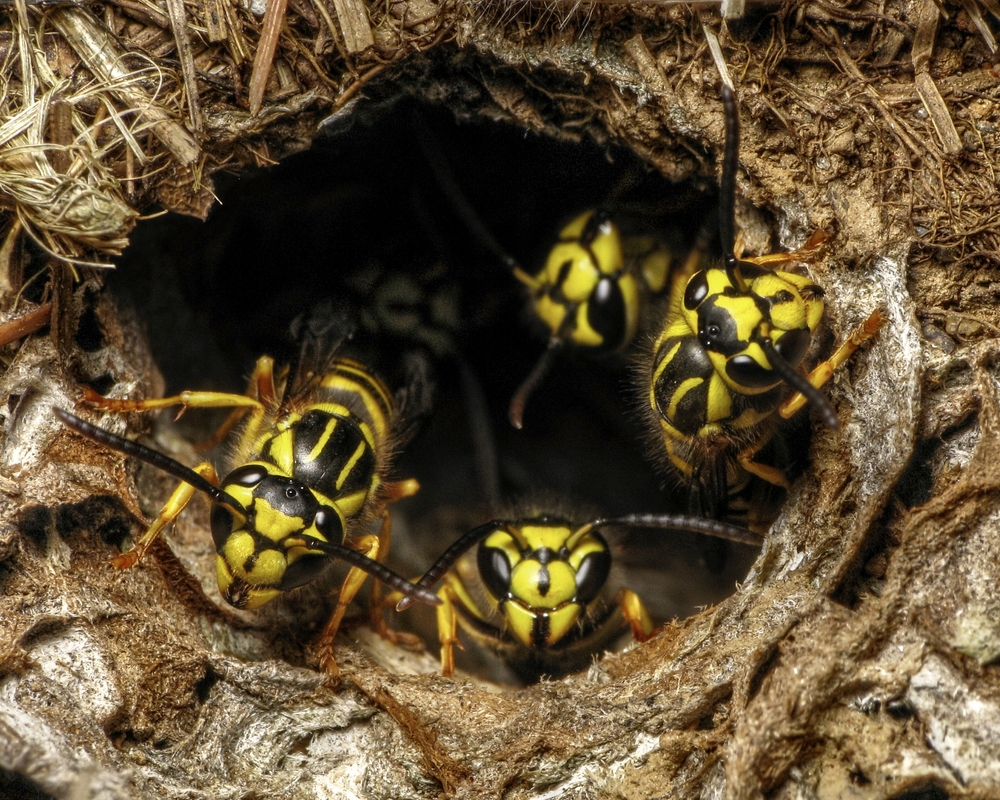Home & Family

The end of summer and fall are peak yellow jacket season in Alabama. Yellow jackets love to terrorize backyards and outdoor picnics. They will attack if their nests are disturbed while mowing the grass or walking on your lawn.
Recognizing Yellow Jackets
Yellow jackets get their name from the bright yellow and black stripes on their bodies. They are commonly mistaken for bees, but they are actually highly aggressive wasps. Yellow jackets have large colonies and fly with a unique rapid, side-to-side pattern prior to landing.
Where do they nest?
Yellow jackets can be found any place where humans live. Yellow jacket nests flourish in the spring, summer and fall before dying off in the winter. Their nests can be both underground or above ground. Constructing their nests from saliva and wood fiber chewed into a fine, paper-like pulp, yellow jacket nests can be hard to spot, but their entrances are typically the size of a nickel. Underground nests are in holes or burrows abandoned by rodents and other feral animals in litter-covered areas by bushes and shrubs. Yellow jackets expand the cavity as the colony develops.
Above ground nests are commonly seen in cavernous areas like eaves, attics, in wall voids, crawlspaces, and cement slabs or cracks. Nests are also found in hollow logs, tree stumps, and inside recycling bins where sugars are common.
Look for small stones and dirt piling up around the opening of a burrow/hole. These are signs of an underground yellow jacket nest. They will also use materials on the ground with available openings, such as railroad ties or concrete blocks.
What do yellow jackets eat?
Yellow jackets are scavengers. They scavenge for sweet liquids like fruits, flower nectar, and tree sap. In late summer, foraging workers are common pests at picnics when they pursue meats, ripe fruits, human garbage, sodas, and picnics to foster a new generation of queens.
Larvae benefit from proteins like insects, meats, and fish. Since many of the meat sources yellow jackets feed on are pest species, yellow jackets are considered beneficial to agriculture.
Why do yellow jackets swarm?
Yellow jackets swarm when someone accidentally or unwittingly steps in, hits, or even comes too close to an underground nest. A dangerous swarm of hundreds of yellow jackets from underground nests can also be provoked by ground vibrations like mowing a lawn. Thus, mowing lawns can be hazardous during the late summer season when colonies are large.
Why do yellow jackets sting?
Bold and aggressive, yellow jackets will attack anything they perceive as a threat. Yellow jackets can also become more aggressive in the fall, as the colony starts to die out.
Sometimes, they sting you for no reason. Even if you are minding your own business and nowhere near a nest, they will sting you if their nest is disturbed or they feel threatened. Yellow jackets can even bite before they sting — grabbing hold of the skin just to get a better grip with their stinger.
They are a danger to humans because they can sting repeatedly; they do not loss their stingers like honeybees do. Yellow jacket stings can trigger dangerous allergic reactions.
When a yellow jacket stings, it tags the victim with an alarm pheromone that may last for hours. This pheromone makes the victim a potential target for other yellow jackets. This is why even a single sting is dangerous. When stung, some people may react differently than others.
Prevent Attacks, Scout for Yellow Jackets
Scout for nests during the day when you can see workers entering and exiting, but treat nests only at night when yellow jackets are drowsy and don’t see very well.
When treating ground nests, locate where the insects fly out and treat the nest early in the morning or after dark. You can pour insecticidal soapy solution or dust products into underground nests and cover the nest opening with a glass-pan cover to trap the yellow jackets inside the nests until they die.
Do not return to the area for at least 24 hours. Such treatment may need to be repeated until there is no visible wasp activity.
Wasp and hornet aerosol sprays have limited effects or are no use eliminating an entire colony. For large colonies, call a licensed commercial pest control company to take care of the problem.
When mowing or doing yard work, wear protective clothes and shoes, including gloves, a hat and possibly even a face mask or bee veil.
Seal garbage cans, clean up after picnics and hang crumpled paper bags outside your doors and the eaves of your home. Yellow jackets will think they are nests and they’ll seek out different territory. Also seal up any awnings or cracks near your home that could serve as prime nesting grounds.
If yellow jackets do invade your home, it is wise to enlist the help of a professional exterminator who has access to specialized equipment and follows stringent safety protocols.

